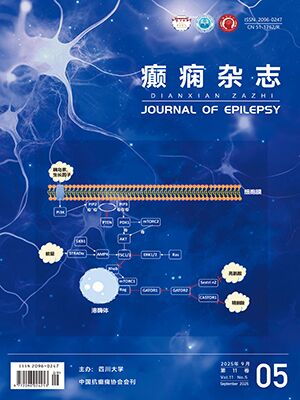| 1. |
Ronzano N, Valvo G, Ferrari AR, et al. Late-onset epileptic spasms: clinical evidence and outcome in 34 patients.Journal of Child Neurology, 2015, 30(2): 153-159.
|
| 2. |
Nordli DR, Korff CM, Goldstein J, et al. Cryptogenic late-onset epileptic spasms or late infantile epileptogenic encephalopathy.Epilepsia, 2007, 48(1): 206-208.
|
| 3. |
Ohtsuka Y, Kobayashi K, Ogino T, et al. Spasms in clusters in epilepsies other than typical West syndrome.Brain Dev, 2001, 23(7): 473-481.
|
| 4. |
Isermann MM, Ville D, Sonfflet C, et al. Cryptegenic late-onset ikpdc spasms: an overlooked syndrome of early childhood.Epilepsia, 2006, 47(5): 1035-1042.
|
| 5. |
Engel J Jr.Report of the ILAE classification core group.Epilepsia, 2006, 47(9): 1558-1568.
|
| 6. |
Caumes R, Boespflug-Tanguy O, Villeneuve N, et al. Late onset epileptic spasms is frequent in MECP2 gene duplication: electroclinical features and long-term follow-up of 8 epilepsy patients.European Journal of Paediatric Neurology, 2014, 18(4): 475-481.
|
| 7. |
Ishikawa N, Kobayashi Y, Fujii Y, et al. Late-onset epileptic spasms in a patient with 22q13.3 deletion syndrome.Brain & Dev, 2016, 38(1): 109-112.
|
| 8. |
吴舒华, 刘晓燕, 张月华, 等.晚发型癫痫性痉挛临床与脑电图特征分析.中国实用儿科杂, 2010, 25(4): 266-270.
|
| 9. |
Lei Chen, Min Zhu, Hao Zhou, et al. Clinical study of West syndrome with PS and late-onset epileptic spasms.Epilepsy Research, 2010, 89(1): 82-88.
|
| 10. |
Ohtsuka Y, Kobayashi K, Ogino T, et al. Spasms in clusters in epilepsise other than typical west syndrome.Brain & Development, 2001, 23(7): 473-481.
|
| 11. |
Auvin S, Lamblin MD, Pandit F, et al. Infantile epileptic encephalopathy with late-onset spasms: report of 19 patients.Epilepsia, 2010, 51(7): 1290-1296.
|
| 12. |
刘晓燕.癫痫性痉挛的临床诊治进展.中华儿科杂志, 2010, 48(4): 312-316.
|
| 13. |
周渊峰, 龚晓妍, 周水珍, 等.晚发型癫痫性痉挛患儿临床特征及生酮饮食近期疗效分析.中国循证儿科杂志, 2015, 10(4): 287-291.
|




